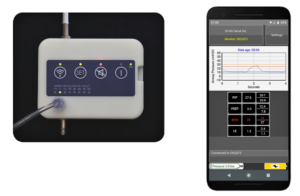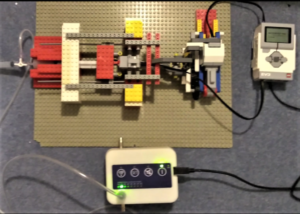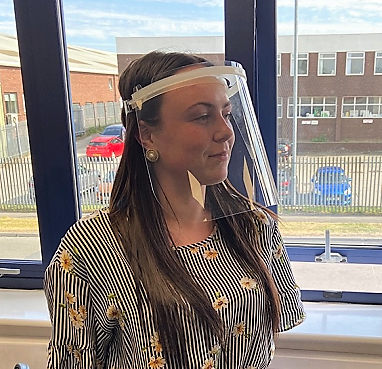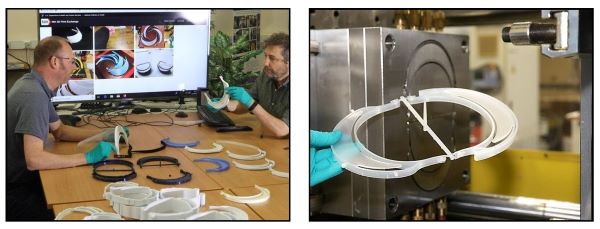Martyn Gray works for Anaesthesia Technology Ltd a company that designs medical devices. Here Martyn describes how with the help encouragement of friends here at MBC he and his colleagues set about responding to the government’s urgent call for help.
 Looking back now, mid March was a surreal time. Saturday 14th March was the first Saturday without sport and BBC 5 Live had turned the day over to a COVID-19 phone in. I was listening to it in the background, two professors called in with slightly different views on the disease and then an anaesthetist called in to point out that it wasn’t just intensive care beds that were required if the worst happened. At that moment the word ventilator became the buzzword. On Sunday morning Rt Hon. Matt. Hancock announced that Rolls Royce and JCB were going to make ventilators, a surprise to all that work in the medical device industry.
Looking back now, mid March was a surreal time. Saturday 14th March was the first Saturday without sport and BBC 5 Live had turned the day over to a COVID-19 phone in. I was listening to it in the background, two professors called in with slightly different views on the disease and then an anaesthetist called in to point out that it wasn’t just intensive care beds that were required if the worst happened. At that moment the word ventilator became the buzzword. On Sunday morning Rt Hon. Matt. Hancock announced that Rolls Royce and JCB were going to make ventilators, a surprise to all that work in the medical device industry.
We had a project in waiting, to add gas supply and patient airway monitoring to a resuscitator, a device that can be used to help people breathe or in its automatic mode breathe for them. It is a simple device to use, supplied to our ambulances and emergency helicopters for patient transfer and in developing countries frequently used as a ventilator. Following Matt Hancock’s announcement we quickly pulled a team together. The resuscitator is manufactured wholly in the UK which was important because obtaining components from abroad was becoming very difficult, the mechanical design of the monitor and regulatory compliance would be managed by a second company and we would design the monitor’s electronics and software.
On the Monday 15th March we sent a short specification to No 10. Rolls Royce announced to the media that they didn’t make ventilators and we got a call from a JCB director who said similar but that they would provide whatever help they could and he provided some contact numbers. The government arranged for consultants to coordinate the technical effort, advice from clinicians was being sought and over nine or ten days we had to work through a dozen ventilator specifications – each an update of the previous one. At the start the requirements were minimal but as we learned more about treating the disease the technical requirements became more detailed.
 It became clear that the virus was very contagious and with the issues around supply of PPE there was a requirement to reduce clinical staff involvement with patients to a minimum. We decided to add remote monitoring to our device. My consultant in this field was John Duffy who had become well acquainted with the “internet of things.” With John’s up to date knowledge we were able add the WiFi functionality to our device. With rapid prototyping of the case in Germany and fast turnaround of the electronics, by the 10th April we had a fully functioning prototype ready for mass production. A team of software engineers in Serbia developed central monitoring software so that data from up to 50 monitors could be displayed on a single remote computer.
It became clear that the virus was very contagious and with the issues around supply of PPE there was a requirement to reduce clinical staff involvement with patients to a minimum. We decided to add remote monitoring to our device. My consultant in this field was John Duffy who had become well acquainted with the “internet of things.” With John’s up to date knowledge we were able add the WiFi functionality to our device. With rapid prototyping of the case in Germany and fast turnaround of the electronics, by the 10th April we had a fully functioning prototype ready for mass production. A team of software engineers in Serbia developed central monitoring software so that data from up to 50 monitors could be displayed on a single remote computer.
At work we could supply gas to the resuscitator for it to drive a lung simulator for testing and calibration of the system, whilst working at home the equipment was limited but I was able to use my son’s leading edge ventilator simulator.
We have supplied 150 systems to the Manchester Nightingale but I do not believe that they have been required. We are now getting enquiries from countries that lack the healthcare infrastructure that we have, places where our system may be a lifeline for some but even if it isn’t used for the pandemic it will be used when life returns to normal.
As well as John’s technical input it was both useful and encouraging to get clinical information from two other MBC members, Claire Taylor (consultant respiratory physician) and Paddy Colling (consultant anaesthetist) both working at the front end throughout.
Meanwhile Professor Phil Coates who is director of The Polymer Interdisciplinary Research Centre, a world class research laboratory at the University of Bradford has two COVID-19 projects running.
 The first involves the design and precision mass production of face visors in conjunction with Leeds company ActiveCell Ltd (who were making 3d printed visors). The Bradford Team developed an injection mouldable solution. This offers significant advantages over 3D printing, with better surface finishes for skin contact; significantly improved process repeatability; better geometric accuracy; significantly higher volume production rates; and lower cost.
The first involves the design and precision mass production of face visors in conjunction with Leeds company ActiveCell Ltd (who were making 3d printed visors). The Bradford Team developed an injection mouldable solution. This offers significant advantages over 3D printing, with better surface finishes for skin contact; significantly improved process repeatability; better geometric accuracy; significantly higher volume production rates; and lower cost.
The final design was created, based on successful candidate 3D printed designs, but with key enhancement: low cost; compatibility with regulatory frameworks for optical safety devices; improved comfort; hooks for surgical masks to relieve ear pressure; and the ability to quickly and easily be completely disassembled into its component parts to enable sterilisation for either reuse or recycling.
This is a key feature, as many of the existing devices used in the NHS use expandable foams and adhesives to join components which, while cheap, cannot be sterilised so all visors must be incinerated after use. The Bradford visor is also designed for use in workplaces as people return to work, so a recyclable option will dramatically reduce the requirement for incineration and the volume of material for landfill. In addition, the device can be supplied as a flat pack solution that can be quickly assembled, which requires much less storage space than existing solutions.
In 5 weeks the team moved from design and prototype to full production. The device is now approved by a PPE test centre. We produce up to 4,800 devices per day and manufacture of an initial order of a batch of 30,000 components is underway. CE marking is being completed and further orders of 400,000+ devices are in negotiation.
Initial press releases:
 The second piece of work is an antiviral materials project, again coordinated by Phil, which started a couple of weeks ago. A novel polymer has been synthesised by our chemists, which may have a similar virus killing action to soap, but with good properties for coating PPE or making devices.
The second piece of work is an antiviral materials project, again coordinated by Phil, which started a couple of weeks ago. A novel polymer has been synthesised by our chemists, which may have a similar virus killing action to soap, but with good properties for coating PPE or making devices.
Coated samples are being manufactured in our laboratory, and are due for antiviral testing at two centres next week – if this shows promise it could clearly be very significant, by removing or reducing virus contamination on treated articles, or lengthening usage time of PPE items such as gloves, masks, visors and gowns.
AN UPDATE FROM PHIL:
Just heard that CE marking of our visor is now completed, that crucially opens up NHS and other supply lines. Also, after a meeting this morning (Thursday) our antiviral materials project now has Liverpool School of Tropical Medicine and Lancaster University undertaking the testing for us, starting next week.
